I fitted a 3.5 Rover V8 into my 109" series III, this article details the modifications I had to do to make it fit and work  This is assuming you have a complete engine with all ancillaries, or a donor vehicle, and that you intend to keep the series running gear.
This is assuming you have a complete engine with all ancillaries, or a donor vehicle, and that you intend to keep the series running gear.
Items needed
Things to be modified/fabricated
Conversion plate
There are many Conversion plates out there for fitting a Rover V8 into a series land rover. I bought mine second hand from ebay for £30 as it was collection only. Make sure you buy one suitable for a series II or Series III depending on your vehicle (Slave cylinder locations differ).
Engine Mounts
I got some modified V8 engine mounts that allowed the V8 to be fitted to the existing series III chassis. A second option is to cut of the engine mounts from a donor vehicle and weld them onto the series chassis, I found the modified mounts were a better option as I did not have to cut into my chassis.
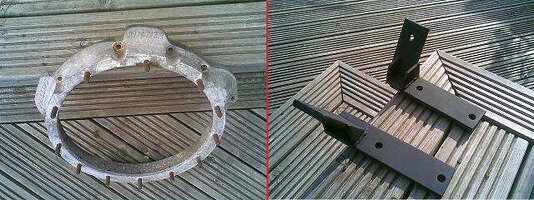
Conversion ring and engine mounts
Remote Oil Filter
The standard location for the oil filter on the Rover V8 interferes with the front diff on a series. The first bump you go over will smash your oil filter and kill the engine.
I purchased a remote Oil filter kit which is basically a plate with two take off's that is fastened to the bottom of the oil pump. You can then use oil pipes to a remote filter head where your oil filter is screwed into. I mounted mine on the drivers inner wing, giving good access for servicing.
These kits will cost you around £100 but are well worth it. If you can get your hands on a 101 oil pump housing then this will also work as it points the oil filter away from the diff, although these are rare and very pricey.
Electric Fuel Pump
Most of the Rover V8's have no facility for a mechanical lift pump so you will need to fit an electrical unit to the vehicle. I used a facet solid state pump and located it on the drivers side outrigger. This is fairly simple and should deliver fuel at no more than 4psi.
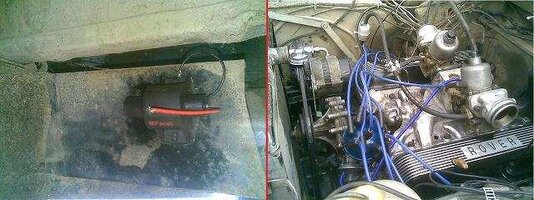
Fuel pump and pipework
Electric cooling Fan
Because of the proximity of the water pump to the series radiator you will not be able to fit an engine driven fan to the land rover. It will be necessary to fit a 'push' style electric fan to the front of the radiator. Fit the biggest one you can as the Rover V8's run warm and will struggle to keep below boiling in the summer if you don' have a powerful fan (14" min).
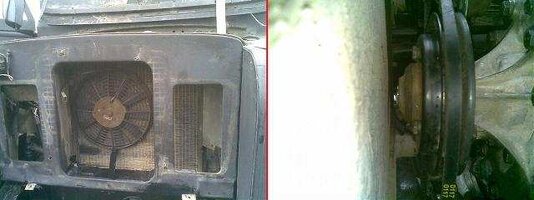
Cooling fan (too small) and water pump clearance
Passenger Foot well
The passenger foot well will need to be modified to accommodate the left bank exhaust manifold. On my vehicle I drilled out all the spot welds from the end plate and put it to one side. I then cut around 2" out of the foot well and refitted the end plate in position with a couple of rivets. I used a piece of flat aluminium sheet to bridge the gap between the end plate and the bulkhead.
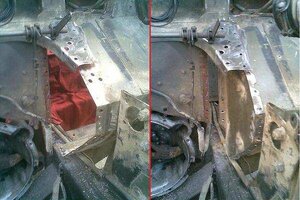
Bulkhead modifications
V8 Flywheel
You have a few options with the flywheel. You can use a Rover car flywheel (SD1) as this will take the series pressure plate and clutch, but will require a spacer between the crank and the flywheel as it is not thick enough.
I used the much more available Range Rover flywheel and had it re-drilled to take the smaller series pressure plate. You can not use the Range Rover pressure plate with the series box as it will not fit. It is best to get a machine shop to do this for you as it has to be accurate, just drop off the flywheel and series pressure plate and they should be able to sort it out.
Spigot Bush
The V8 and series spigot bush's are quite different in size. You can buy adapters that require you to cut the end of the engine crank but I wasn't too keen on this option. I got the same machine shop that did my flywheel (well my dad) to turn a new bush for me.
I gave him a series bush and a V8 bush, with instructions to machine the inside of the series bush to the same diameter as the inside of the V8 bush. The result was a very thin spigot bush but it seems to have worked perfectly and I have had no issues.
I got him to machine two so I have a spare, this cost pennies!
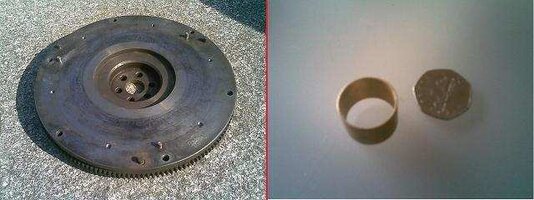
Machined flywheel and spigot bush
Exhaust System
For the exhaust system I used Range Rover manifolds, downpipes and Y-pipe This was all mated up to a Honda back box and tail pipe as it was the same bore. Not idea but has done the job. If you intend on using the downpipes without modification you will have to replace the bulkhead cross member with a bolt in job, else you can cut and modify the exhaust system around it.
Steve parker also sell a complete system for the conversion however it is quite pricey, over £200

Its not great but its air tight and sounds awesome
Throttle Linkages
I have a hand throttle so wanted to retain my rod system along the bulkhead. I used a throttle cable kit from ebay to link the rod system up to the throttle linkages on the carb. An easier solution would have been to use a defender throttle pedal, and I would recommend this if you have no hand throttle.
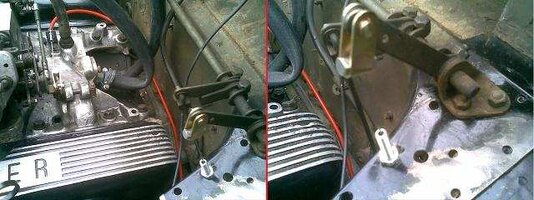
Rod to cable linkage
Wiring Loom
You will have to modify and extend certain parts of the wiring loom, coolant temperature sensors and the distributer are all out of reach of the existing wiring. If possible use the same gauge and colour wire as the original. Solder all joints to ensure they last.
The V8's starter solenoid is located on the starter body so you will need to extend the cabling here also.
Radiator
You will also need to add a port into the top of the radiator to run the steam pipe into. This pipe comes from the inlet manifold and helps prevent airlocks when filling the radiator and prevents steam building up in the inlet manifold. The inlet manifold on the rover V8 has coolant flowing through it.
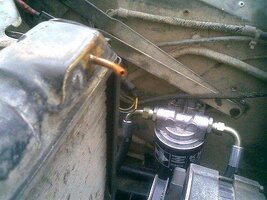
Steam pipe (copper brake line brazed into radiator). Also visible the remote filter.
Cab Heater matrix
The Series engine has a valve that is operated by the lever on the side or the dash to control hot water flow to the heater matrix, the V8 does not have such a valve. I plumbed mine in directly to the coolant flow so I always get warm air. In the summer the roofs off so this does not bother me.
I do intend to install a inline valve at some point so I can stop the flow during the summer months.

The finished article
Items needed
- Conversion plate
- Engine mounts
- Remote Oil filter
- Electric Fuel Pump
- Electric Cooling Fan
Things to be modified/fabricated
- Passenger foot well/bulkhead
- V8 Flywheel
- Spigot Bush
- Exhaust system
- Throttle Linkages
- Wiring Loom
- Radiator
- Cab Heater
Conversion plate
There are many Conversion plates out there for fitting a Rover V8 into a series land rover. I bought mine second hand from ebay for £30 as it was collection only. Make sure you buy one suitable for a series II or Series III depending on your vehicle (Slave cylinder locations differ).
Engine Mounts
I got some modified V8 engine mounts that allowed the V8 to be fitted to the existing series III chassis. A second option is to cut of the engine mounts from a donor vehicle and weld them onto the series chassis, I found the modified mounts were a better option as I did not have to cut into my chassis.

Conversion ring and engine mounts
Remote Oil Filter
The standard location for the oil filter on the Rover V8 interferes with the front diff on a series. The first bump you go over will smash your oil filter and kill the engine.
I purchased a remote Oil filter kit which is basically a plate with two take off's that is fastened to the bottom of the oil pump. You can then use oil pipes to a remote filter head where your oil filter is screwed into. I mounted mine on the drivers inner wing, giving good access for servicing.
These kits will cost you around £100 but are well worth it. If you can get your hands on a 101 oil pump housing then this will also work as it points the oil filter away from the diff, although these are rare and very pricey.
Electric Fuel Pump
Most of the Rover V8's have no facility for a mechanical lift pump so you will need to fit an electrical unit to the vehicle. I used a facet solid state pump and located it on the drivers side outrigger. This is fairly simple and should deliver fuel at no more than 4psi.

Fuel pump and pipework
Electric cooling Fan
Because of the proximity of the water pump to the series radiator you will not be able to fit an engine driven fan to the land rover. It will be necessary to fit a 'push' style electric fan to the front of the radiator. Fit the biggest one you can as the Rover V8's run warm and will struggle to keep below boiling in the summer if you don' have a powerful fan (14" min).

Cooling fan (too small) and water pump clearance
Passenger Foot well
The passenger foot well will need to be modified to accommodate the left bank exhaust manifold. On my vehicle I drilled out all the spot welds from the end plate and put it to one side. I then cut around 2" out of the foot well and refitted the end plate in position with a couple of rivets. I used a piece of flat aluminium sheet to bridge the gap between the end plate and the bulkhead.

Bulkhead modifications
V8 Flywheel
You have a few options with the flywheel. You can use a Rover car flywheel (SD1) as this will take the series pressure plate and clutch, but will require a spacer between the crank and the flywheel as it is not thick enough.
I used the much more available Range Rover flywheel and had it re-drilled to take the smaller series pressure plate. You can not use the Range Rover pressure plate with the series box as it will not fit. It is best to get a machine shop to do this for you as it has to be accurate, just drop off the flywheel and series pressure plate and they should be able to sort it out.
Spigot Bush
The V8 and series spigot bush's are quite different in size. You can buy adapters that require you to cut the end of the engine crank but I wasn't too keen on this option. I got the same machine shop that did my flywheel (well my dad) to turn a new bush for me.
I gave him a series bush and a V8 bush, with instructions to machine the inside of the series bush to the same diameter as the inside of the V8 bush. The result was a very thin spigot bush but it seems to have worked perfectly and I have had no issues.
I got him to machine two so I have a spare, this cost pennies!

Machined flywheel and spigot bush
Exhaust System
For the exhaust system I used Range Rover manifolds, downpipes and Y-pipe This was all mated up to a Honda back box and tail pipe as it was the same bore. Not idea but has done the job. If you intend on using the downpipes without modification you will have to replace the bulkhead cross member with a bolt in job, else you can cut and modify the exhaust system around it.
Steve parker also sell a complete system for the conversion however it is quite pricey, over £200

Its not great but its air tight and sounds awesome
Throttle Linkages
I have a hand throttle so wanted to retain my rod system along the bulkhead. I used a throttle cable kit from ebay to link the rod system up to the throttle linkages on the carb. An easier solution would have been to use a defender throttle pedal, and I would recommend this if you have no hand throttle.

Rod to cable linkage
Wiring Loom
You will have to modify and extend certain parts of the wiring loom, coolant temperature sensors and the distributer are all out of reach of the existing wiring. If possible use the same gauge and colour wire as the original. Solder all joints to ensure they last.
The V8's starter solenoid is located on the starter body so you will need to extend the cabling here also.
Radiator
You will also need to add a port into the top of the radiator to run the steam pipe into. This pipe comes from the inlet manifold and helps prevent airlocks when filling the radiator and prevents steam building up in the inlet manifold. The inlet manifold on the rover V8 has coolant flowing through it.

Steam pipe (copper brake line brazed into radiator). Also visible the remote filter.
Cab Heater matrix
The Series engine has a valve that is operated by the lever on the side or the dash to control hot water flow to the heater matrix, the V8 does not have such a valve. I plumbed mine in directly to the coolant flow so I always get warm air. In the summer the roofs off so this does not bother me.
I do intend to install a inline valve at some point so I can stop the flow during the summer months.

The finished article
